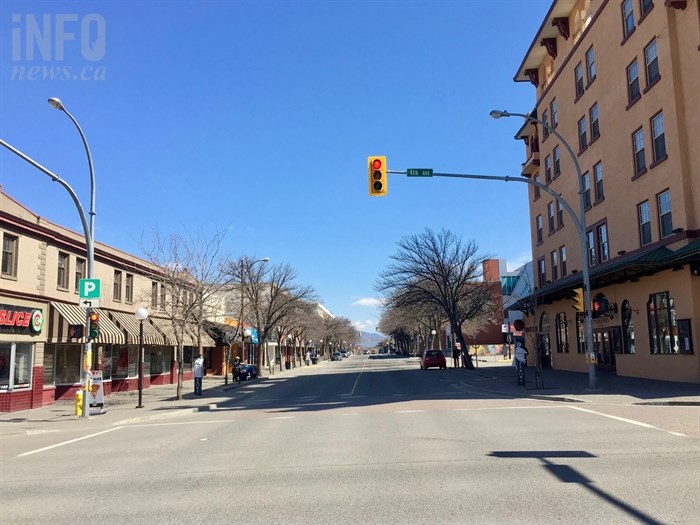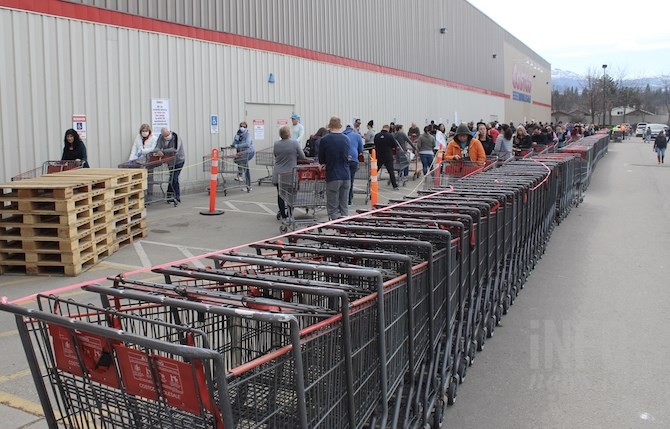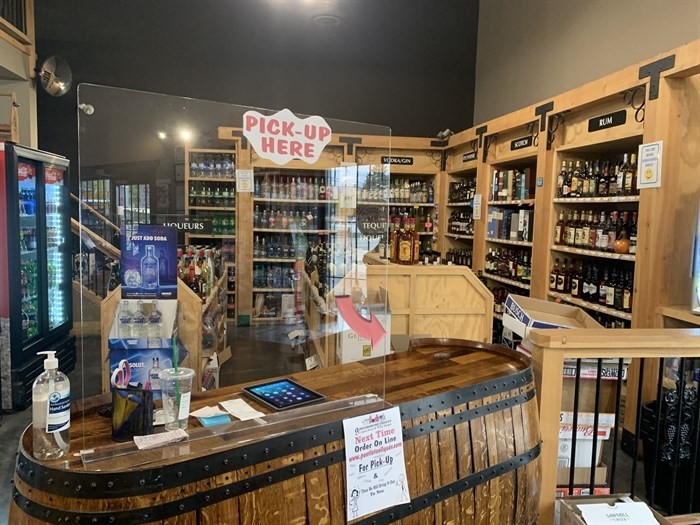
Today marks the first anniversary of COVID-19 being declared a pandemic. That led to scenes like this, Highway 97 in Kelowna. being virtually deserted in the middle of the afternoon on March 22, 2020.
(ROB MUNRO / iNFOnews.ca)
March 11, 2021 - 3:18 PM
Everyone remembers 9/11, that day on Sept. 11, 2001 when planes flew into the World Trade Centre in New York, killing close to 3,000 people and starting the War on Terror.
But,an equally poignant date that has not yet caught the public imagination is 3/11. That’s March 11, 2020 when the World Health Organization declared the novel coronavirus – now better known as COVID-19 or just COVID – to be a world pandemic.
That was well after the disease first broke out in Wuhan, China in December 2019 – therefore the number 19 in the name – and well after the first case was detected in B.C. on Jan. 25, 2020.
“By using the charged word ‘pandemic’ after shying away from calling it so earlier, the U.N. health agency sought to shock lethargic countries into pulling out all the stops,” states an Associated Press news story that ran on iNFOnews.ca on March 11, 2020.
READ MORE: WHO declares coronavirus a pandemic, urges aggressive action
Canada was not one of those countries that needed to be told to pull out all the stops. Nor was B.C.
On that same day, March 11, Prime Minister Justin Trudeau announced a $1 billion aid package to provinces to respond to the crisis.
By the end of November, that had grown to $322 billion and continues to grow.
The initial package included changes to sick leave entitlement under the Employment Insurance program, eliminating the one-week waiting period.
It wasn’t until March 25, 2020 that the $500 per week CERB (Canada Emergency Response Benefit) was announced to aid people laid off because of COVID.

Busy thoroughfares, like Victoria Street in downtown Kamloops, became deserted.
(JENNA WHEELER / iNFOnews.ca)
On March 11, 2020, there were only 117 cases of COVID in all of Canada. B.C. led the way with 46, followed by Ontario (42), Alberta (14) and Quebec (eight).
B.C. also led the way with the country’s first, and at that time, only death.
Now, more than 22,000 Canadians have died of COVID-19, with almost 1,400 of those being British Columbians.
Canadians did not need the World Health Organization to tell them to get serious about the novel coronavirus.
By Feb. 26, Canadian Health Minister Patty Hajdu had already urged people to stockpile food and medication in their homes, just in case.

It wasn't just toilet paper that disappeared from store shelves.
(BEN BULMER / iNFOnews.ca)
That sparked a national frenzy of toilet paper hoarding, of all things.
READ MORE: Toilet paper frenzy: Kelowna residents clear out store shelves over coronavirus concerns
Staples disappeared from grocery store shelves as well, while most other retailers, restaurants and bars simply closed.
On March 11, 2020, the World Figure Skating Championships, scheduled for Montreal later that month, was cancelled. That was the start of the end for most sporting events last spring, with the NHL, WHL and BCHL all suspending their hockey seasons on March 12. The Canadian Football League cancelled the 2020 season.
Also on March 12, Provincial Health Officer Dr. Bonnie Henry declared a public health emergency followed, a day later, by Premier John Horgan declaring a state of emergency. Both continue to this day.
People stayed home in self-isolation for two weeks at the slightest hint of a cold.
Safe distancing became the norm, as did working from home but mask wearing was discouraged by Dr. Henry at that time, because it conflicted with another important measure — don't touch your face.
It wasn’t long before Zoom not only became normal but Zoom fatigue became a thing that persists to this day.
READ MORE: The highs and lows of connecting through video conferencing for Kelowna non profits
It would be almost another week, March 16, before Canada closed its borders to most foreign travellers and airports everywhere ground to a near standstill.

Signs of gratitude for health care workers sprang up everywhere. This one was in Lake Country.
(BEN BULMER / iNFOnews.ca)
Thanking front line health care workers became almost a competition to see who could do it best or loudest but B.C. seemed to settle on the 7 p.m. shift changes to bang pots and pans. Hearts appeared in many windows to support them as well.
READ MORE: iN VIDEO: Kamloops construction crews parade for health care workers
Playgrounds, gyms and rec centres closed but cycling and hiking trails saw huge increases in use.
March 16 was also the start of B.C.’s Spring Break for school students. They were discouraged from travelling and did not return to in-class teaching until after the May long weekend – and that was only a partial return.
By then, retail businesses were closing, sporting and cultural events were cancelled and the Interior’s largest shopping centre, Orchard Park mall, was “eerily quiet” after cutting back its opening hours.
READ MORE: Kelowna’s Orchard Park Mall eerily quiet
READ MORE: iN VIDEO: Kamloops construction crews parade for health care workers
Playgrounds, gyms and rec centres closed but cycling and hiking trails saw huge increases in use.
Liquor sales skyrocketed.
“I think generally, customers do tend to stockpile products just in case, and liquor is one of those products people like to have on hand if they’re expecting to be inside for an extended period of time,” Kate Bilney, manager of corporate social impact for B.C. Liquor Distribution Branch said at the time.
READ MORE: B.C. Liquor Stores notice 'healthy' increase in sales during virus outbreak
Liquor and cannabis stores made the list of essential services in B.C. While there were no limits on those products and there weren’t shortages, limits were placed on the amount of prescription drugs people could buy at any one time.
READ MORE: Drug wholesalers limiting supply to pharmacies to prevent hoarding
Grocery store workers were also deemed so essential to keeping the world going that many retailers paid an extra $2 an hour for being on the front lines of the pandemic.
Panic buying continued as toilet paper was in short supply. Even non-hoarders had to scramble when their own supply ran low. One woman we spoke to went to Walmart, Superstore and Save on Foods before finally got what she needed from a dwindling supply in Peachland.
READ MORE: Kelowna shoppers increasingly frustrated as COVID-19 panic buying makes getting the basics harder
Costco experienced huge lineups as people lined up and safe-distanced with the shopping carts.

Costco lineups in Kelowna looped around the building..
(ROB MUNRO / iNFOnews.ca)
PPE became such a common term that no one said Personal Protective Equipment anymore as it became harder and harder to keep up the supplies needed for health care workers.
READ MORE; Kelowna doctor says there's a 'critical shortage' of masks, PPE for healthcare workers
The federal government brought in a 75 per cent wage subsidy to help small businesses survive but the Canadian Federation of Independent Businesses reported 32 per cent of small businesses across the country had closed.
All that happened by the end of March. In April, retailers started to reopen with the creative use of plexiglass.
READ MORE: West Kelowna company leading the way as we turn into a Plexiglass world

Plexiglass became the essential ingredient before most stores could reopen. This was the Government Street Liquor Store in Penticton.
Image Credit: Submitted/Jeff Leonard
It wasn’t until late May that B.C. restaurants were allowed to reopen after months of trying to keep afloat through delivery and curbside pickup services.
READ MORE: Okanagan, Kamloops delivery services see massive uptick during COVID-19 pandemic
That, obviously, did not mark the end of the pandemic, but ended the worst of the lockdown with panic-buying.
COVID-19: A timeline of the pandemic and how it changed our lives over the past year
Now, of course, we are heartened by a possible reprieve amid the promise of various vaccines and waiting for a complete rollout, while keeping a close eye on variants of the virus that threaten to be more deadly or more contagious and wondering what happens next.
To contact a reporter for this story, email Rob Munro or call 250-808-0143 or email the editor. You can also submit photos, videos or news tips to the newsroom and be entered to win a monthly prize draw.
We welcome your comments and opinions on our stories but play nice. We won't censor or delete comments unless they contain off-topic statements or links, unnecessary vulgarity, false facts, spam or obviously fake profiles. If you have any concerns about what you see in comments, email the editor in the link above.
News from © iNFOnews, 2021